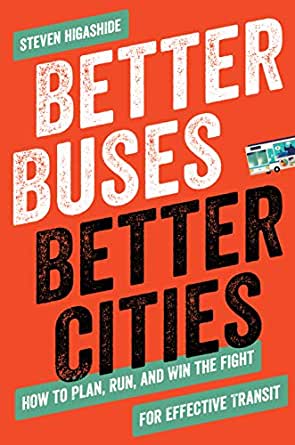After years of laying the groundwork, the coalition behind the proposed "Faster Bay Area" (FASTER) ballot measure decided back in March to postpone their efforts in light of the uncertainty caused by COVID-19. In the statement announcing their decision, the group stated:
FASTER’s proposed investment framework and structural changes are still a critical priority for our organizations and partners. We believe the additional time we will have will make the FASTER Framework even stronger by allowing us to build on the robust work that has been done to date.

As FASTER regroups for 2021 or 2022, Streetsblog decided that we would reach out to experts that bring different lenses to ballot measures, a mix of local advocates, national analysts, and veterans of ballot measure campaigns from other parts of the country, for their thoughts. Yesterday, we spoke with Steven Higashide, the Director of Research at Transit Center and author of Better Buses, Better Cities: How to Plan, Run, and Win the Fight for Effective Transit.
Streetsblog SF (SBSF): Transit Center is one of the leading research organizations when it comes to looking at how transportation is funded and how we can do better. As you've studied ballot measures across the country (ones that have passed, ones that haven't passed, ones that are just going to the ballot), what do you see as the most important thing coalitions and supporters can do when they're about two years out from seeing a measure on a ballot?
Steven Higashide (SH): The first thing you should look at is the coalition itself. Who is in it? Who runs it? Who has power?
Transit Center has done research on ballot initiatives, successful and unsuccessful. When you look at a lot of the unsuccessful ballot measures, you see these coalitions that look impressive on paper but are clearly controlled by a small group of business leaders. That was the case in Nashville. I heard similar complaints about some of the early ballot measures in Metro Detroit.
People can tell when you have dozens of organizations on the press release, but decisionmaking runs through the business community. That doesn't mean that business is unimportant; it is important for business to be at the table and sharing resources. There's a difference between when power is shared, and when business thinks it can call the shots because it has the most money.
The best example of how to put business in its proper place is the Indianapolis ballot measure, where the realtors and business organizations were really on equal footing with groups such as the Indianapolis Congregational Action Network, now called Faith in Indiana - groups that were deeply rooted in racial justice and were doing organizing in black neighborhoods.
Similarly, in Raleigh there was a measure led by civic organizations such as Wake Up Wake County. Recent wins in Seattle and Cincinnati were led by groups that did organizing with actual transit riders.
But in Nashville, business leaders put up a lot of money. They vastly outspent their opponents, but still lost big. That has a lot to do with who is in the coalition, and that has a lot to do with what messages are spread.
Of course, it also has a lot to do with what is actually in the ballot initiative.
SBSF: When we were first discussing this interview, you sent me the Transit Center report on the Nashville ballot measure, which looked at the reasons it failed. Correct me if I'm wrong, but the project list was based off information in a recently completed long-term plan. That seems great on paper, but it also sort of skips the step of doing outreach before the measure is on the ballot. I mean, there's a lot more interest in project lists for ballot measures when there's money on the table than in a plan that may or may not happen.
SH: What is interesting about the Nashville case is that the transit plan looked like a long-range plan that the transit agency put together after quite a lot of public engagement.
However, there's a couple of things that were lost in translation.
The first is that there was a lot of outreach for the long-range plan, but it wasn't representative. Whiter, wealthier people were over-represented. It appeared there was a lot of enthusiasm for the plan, but it wasn't as widespread as people thought.
Second, the project list that was placed on the ballot actually was more heavily focused on light rail investments, and didn't include many of the bus operations that were in the long-range plan.
It was a dynamic where the mayor's aides, and business leaders, and a few other grass tops stakeholders essentially put the plan together in a back room. They felt the mayor was personally very popular, so let's make it a big-dollar plan focused on projects having economic development value. But a lot of the ground level details that matter to people actually using transit in Nashville - more frequent bus service, safer sidewalks...those got some lip service in the plan, but actually had less focus than in the long-range plan.
That speaks to how a very elite-driven coalition comes up with a project plan that appeals mostly to people like them.
SBSF : Groups in the Bay Area are starting to put the pieces back together from Faster Bay Area, which was shelved in the early days of COVID-19 shutdowns. The three groups that led the charge for Faster Bay Area were the Bay Area Council, Silicon Valley Leadership Group, and SPUR.
The first two are business groups. Perhaps more progressive than many business groups, but essentially business groups. The other is SPUR, which is a regional planning nonprofit.
Now I love SPUR, but if I understand what you're saying, it's that even if there are other groups involved, they still need to elevate some of the groups that have boots on the ground and roots in different communities to the table where decisions are being made.
SH: That's exactly what I'm saying.
This is often born out in the polling and public opinion research that's been done for prior ballot initiatives. In places such as Nashville and Indianapolis and Raleigh, messages around providing mobility for everyone, providing mobility for seniors, providing mobility for people who can't or won't drive, and about providing safe sidewalks and a safe walking experience - these really resonate with voters, even thought it's pretty different than what a Silicon Valley business leader is prioritizing or seeing as the value in a transit investment.
Of course it matters to make big transformative investments in regional mobility, but people's lived experience in transportation is often encountering repeated failure at a basic level such as walking to the bus stop.
Promising to make those things better, and following through on them, is really important to winning public support.
SBSF: There is likely at least one Bay Area ballot measure in the fall this year. The measure still needs approval from a couple of local governments, but it looks like it's headed to the fall ballot. Caltrain released a poll that showed, not surprisingly since they released it, strong support for the measure: an 1/8 cent sales tax that will fund electrification, newer cars, increased service, and actually head off long-term COVID-related cuts.
But their strongest supporters are either people that are riding Caltrain or stopped because of COVID but are planning to return quickly.
SH: Yes, we should be making investments that are a direct response to what transit riders experience.
But I should add that even in the Bay Area, it's not enough to rely on just the votes of transit riders. You'll need the votes of hundreds of thousands of people that aren't regular transit riders. But it turns out that these voters respond to messages around how transit provides affordable mobility to people who would otherwise have a hard time getting around.
But it has to go beyond the message. It has to be those types of investments that aren't simply driven by 'elite needs.'
What I'm about to say is something that's not backed by any public opinion research. But in the context of the coronavirus in relation to Caltrain, think about whether this is a system that is accessible to essential workers when, like a lot of commuter rail systems, the fare system is a lot greater than local transit.
Does it (the ballot measure) make sense, based on where transit demand is right now? What would it look like if there were a fare structure that was responsive to where essential workers need to go? Is that something we should be paying for?
SBSF: When I'm talking about some of these larger projects I try to avoid the term "essential workers" because it seems to mean something different in every state. Heck, in Florida they consider professional wrestlers 'essential workers.'
But regardless of the term we use, looking at how transit systems do and don't serve the people that are keeping the economy working and providing the services we need for people to survive is important. If it's not working for them now, it's probably never working for them. So we can see the kinds of changes we need to make.
That being said, there was a paper put out in April by the Untokening that said, along with a lot of other things, that cities and agencies should avoid making long-term decisions right now as our public process is clearly broken, with stay-at-home orders and access to online meetings being inequitable.
SH: These are things that are important to think about for planners and advocates. I don't know that I have settled answers to all of it.
I think that when you look at cities responding to and adapting to the pandemic, you can see that there's an incoming emergency in that automobile traffic is on the rebound faster than transit is.
That means we may be relegating transit riders to being stuck in traffic even though we know that means we are going to increase the health risk. It's going to make it harder for people to get to work and meet their needs reliably. I think it is important for cities to act quickly to prevent that from happening to reduce car impacts to people that are relying on transit.
I think that is a lot different than saying, "How do we use that opportunity to implement our urbanist fantasy or whatever." I think it's important to center vulnerable people in the decision making process and in measuring the impacts and benefits of transportation decisions.
That means there is a big difference between moving to prioritize transit on the street because you want to keep transit reliable than carving out space for restaurants.
SBSF: We're running up against our artificially created time limit. Is there anything you'd like to add in closing?
SH: One thing I'd add is that people working on referendums around the country are coming to conclusions about a similar need to rethink the traditional funding sources for transit.
Of course, the main way transit's been funded is through sales tax, which is regressive and proving fragile in this economic climate and it can create a kind of tax fatigue. In places such as Seattle, people have been asked to raise the sales tax over, and over, and over again. There's been some local polling that shows that different funding sources should be looked at.
It's worth looking at what funding sources are more progressive, which sources are more sustainable.
It's also important to marry some of the resources that business groups can provide with organizing and leadership from groups that are led by people of color, groups that are organizing transit riders.
It's not just how you win, it's how you create transit that's actually useful for people.
(Disclosure: Higashide and Damien Newton, who conducted this interview, briefly worked together at the Tri-State Transportation Campaign in 2007.)






